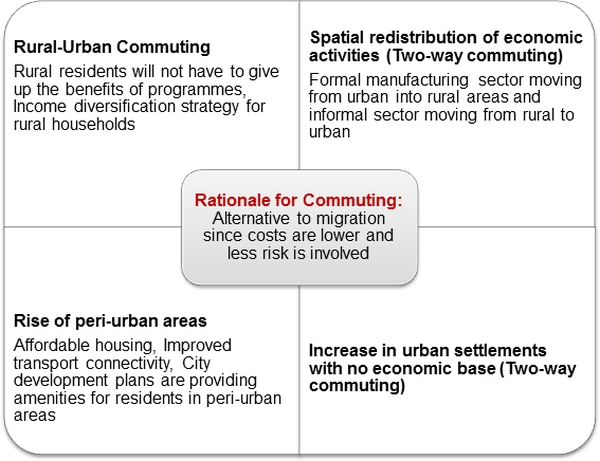About 25 million workers in India commute daily for work, from rural to urban areas or vice versa, or have no fixed place of work. This column finds that rural households with at least one rural-to-urban commuting worker are better off than those with no commuting workers. It makes a case for shifting the focus of labour mobility discussions from migration to commuting.
The traditional view is that lack of productive jobs in the rural economy will induce individuals to migrate. While there is merit in this point of view, with improvements in transport connectivity, individuals are more likely to commute from rural areas daily rather than migrate to their place of work. Today, a large number of workers living in rural areas indeed commute long distances daily in developing countries. This phenomenon has been observed in many countries including India, Indonesia, North Western Tanzania and South Eastern Nigeria.
The phenomenon of commuting for work in India
In the context of workers engaged in non-agricultural activities and commuting across rural-urban boundaries on a daily basis in India, Mohanan (2008) writes, “...movement of rural workers to urban areas is somewhat reinforced by the daily picture of overcrowded trains and buses bringing people to the cities and towns from the surrounding areas, sometimes called the floating population”.
Larger magnitudes of commuters will contribute to the integration of rural and urban labour markets, reduction of regional unemployment, and narrowing of wage differences between rural and urban areas.
We use data from various rounds of National Sample Survey Organisation’s (NSSO) surveys of employment and unemployment to estimate the size of the commuting non-agricultural population in India, and to analyse whether households with commuting workers are better off (Chandrasekhar and Sharma 2014). As per data from 2009-10, 13.26% of the non-agricultural rural workforce in India either commutes from rural to urban or has no fixed place of work. For urban areas, the corresponding number is 13.05%. In terms of absolute numbers, we estimate that 12.42 million workers engaged in non-agricultural activities crossed the rural-urban boundary everyday (8.05 million rural-urban commuters and 4.37 million urban-rural commuters). In addition, 12.2 million non-agricultural workers living in rural and urban areas reported not having a fixed place of work.
In contrast, in 1993-94, only 6.34 million individuals were crossing the rural-urban boundary every day for work. Considering rural-urban, urban-rural commuters and those with no fixed place of work, we observe a nearly four-fold increase (from 6.34 million to 24.62 million) in the number of two-way commuters between rural and urban areas.
Figure 1. Rationale for commuting

Factors that have contributed to an increase in two way commuting between rural and urban areas include: growth of employment opportunities just outside city boundaries, fresh investment in non-metropolitan districts in the last two decades, and the shift in the location of formal (informal) manufacturing sector from urban to rural (rural to urban) areas. Akin to the case of migration, rural-urban differences in wages and local unemployment rates are important push and pull factors that affect the decision to commute. What this suggests is that commuting by workers can help reduce regional unemployment and narrow wage differences between rural and urban areas. Furthermore, large investments in transport infrastructure have facilitated commuting by workers.
Are households with commuting workers better off?
The natural follow up question is whether households with commuters are better off in one or more dimensions. In fact, there are differences in monthly per capita consumption expenditure (MPCE), food consumption patterns, and dietary diversity across three mutually exclusive types of households: where all members work in rural areas, at least one member commutes to urban areas, or at least one member has no fixed place of work. As compared to households with no commuters, households with rural-urban commuters have higher MPCE and dietary diversity; whereas households with no fixed place workers have lower MPCE and dietary diversity.
Table 1. Household per capita consumption expenditure and commuting

Concluding remarks
In effect, we are making two points. One, the size of the commuting workforce is large. Second, rural households with rural-urban commuters are better off. Hence, we feel that the discussion on labour mobility in the Indian context needs to move away from being migration centric to one of commuting.
In this decade, three factors will contribute to a steady stream of commuter workers. The first factor is improved transport linkages between rural and urban India. The fact is that eventually 640 districts of India, the 5,924 sub-districts, the 7,935 towns and 640,867 villages spread across 35 states and union territories will be interlinked. The second factor is an increase in the number of towns from 5,161 in 2001 to 7,935 towns in 2011. It is possible in many of the small towns the flow of workers would be from urban to rural since these towns might not have a robust economic base. The third factor, the spatial diffusion of construction, manufacturing and the wholesale and retail trade activity, will give impetus to the phenomenon of commuting.
Further Reading
- Chandrasekhar, S (2011), “Workers Commuting between the Rural and Urban: Estimates from NSSO Data”, Economic and Political Weekly, November 2011, Vol. XLVL no 46, P. 22-25.
- Chandrasekhar, S and Ajay Sharma (2014), “Growth of the Urban Shadow, Spatial Distribution of Economic Activities, and Commuting by Workers in Rural and Urban India”, World Development, Vol. 61 (September 2014), Pages 154-166.
- Chandrasekhar, S and A Sharma (2014), ‘Impact of Commuting by Workers on Household Consumption and Dietary Diversity Rural India’, Manuscript, Indira Gandhi Institute of Development Research, Mumbai.
- Mohanan, PC (2008), “Differentials in the rural–urban movement of workers”, The Journal of Income and Wealth, 30(1), 59–67.




 10 September, 2014
10 September, 2014 





Comments will be held for moderation. Your contact information will not be made public.